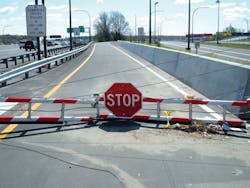Gate Stoppers
A StopGate System from Quixote Transportation Safety Inc. that was put into operation earlier this year on eastbound I-495, the Long Island Expressway (LIE) near Plainview, N.Y., at a truck weigh station ramp at Exit No. 46 was impacted by a driver. New York State Department of Transportation (NYDOT) authorities report the driver errantly attempted to exit onto the ramp leading to the weigh station. The motorist impacted the gate, which did not allow the vehicle to penetrate and enter the ramp leading to the inspection and weigh station.
The StopGate did its job because, while the intruder drove away after being stopped by the gate, there was no report of injury to the driver or damage to the weigh station facility.
The StopGate System on the LIE was installed by local contractor J.D. Posillico and was struck by the errant vehicle just one week after being opened this past spring.
The LIE incident was the second reported hit of the Energy Absorption Systems’ StopGate System barrier where the system’s gate arm successfully prevented intrusion of a vehicle into a dangerous area. According to local authorities, during the winter of 2004, a Wisconsin and Southern Railroad train was leaving a Badger State Ethanol plant located less than a mile west of a railroad crossing on Rte. 69, just south of downtown Monroe, Wis., when a pickup truck impacted the StopGate System’s gate arm at the Rte. 69 bypass crossing.
It was estimated that the truck was traveling about 15 to 20 mph when it impacted the StopGate System , which caused damage to the gate arm. The arm performed as designed and did not allow penetration through, just as a standard flashing-light warning gate would have. A witness in a residential trailer park located right next to the crossing reported a loud bang, and when he looked out his window he saw the vehicle fleeing the scene in the opposite direction.
“This was always one of our greatest fears,” Wisconsin Railroad Commissioner Rodney Kreunen said at the time. “Had the gate arm not done its job—or had it not been there—and the vehicle hit one of those loaded tankers, we don’t like to imagine what could have happened.”
The StopGate System's technology ultimately changes the safety feature at a railroad crossing or other area where intrusion is prohibited from one simple warning via flashing lights to one of positive, crashworthy protection.
The StopGate System's gate arm is deployed using a vertical pivot action—similar to a crossing warning gate—and utilizes a positive locking device at each end of the arm to secure the gate across the roadway. The locking mechanism at the far end of the gate arm is located on the side of the roadway, which helps prevent vehicles from driving around the gates, making the crossing safer for both motorists and trains.
Maximum gate width is 55 ft and it is accepted by the FHWA as a NCHRP 350 TL-2 attenuator that can stop a 4,410-lb pickup truck traveling at 44 mph in as little as 13 ft away. It is designed for standard, vertical-to-horizontal arm deployment for applications with limited space requiring positive protection.
